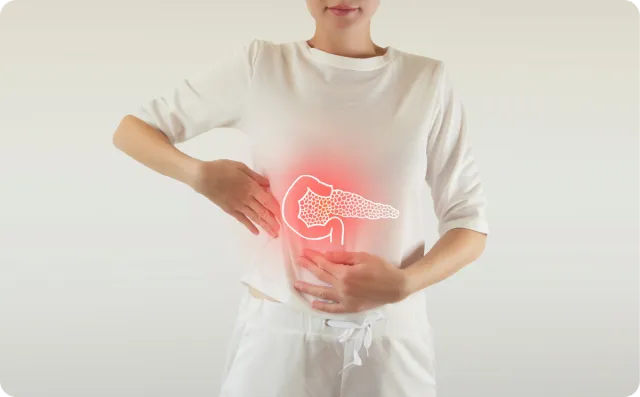
Jump to
Book a visit
$25 typical copay
$150 without insurance
Get answers today about your stool color concerns from a GI specialist.
A virtual GI consultation lets you discuss stool color changes with an expert, helping you identify potential causes and the next steps in your treatment.
Key takeaways:
- Gray or clay-colored stools are usually due to an issue with how much bile is reaching the intestines.
- Giving your healthcare provider a full medication list can help them differentiate between benign and more serious causes of gray poop.
- If you experience gray poop, this symptom should not be overlooked and you should promptly consult your healthcare provider.
Gray poop can be an alarming sight, and for good reason. While most people expect to see shades of brown in their stool, a grayish color almost always indicates a serious underlying condition related to a person's digestive health.
In this article, we will review the potential causes of gray poop, how to manage this symptom, and why it is important to seek medical attention at the first sight of gray poop.
Is gray poop normal?
Gray poop is not typically considered normal. The normal color of stool usually ranges from light to dark brown, influenced by bile and dietary factors.
When stool appears gray, it may indicate an absence of bile reaching the intestines or other serious issues impacting the digestive tract. The only time this symptom may be considered “normal” is when it is experienced as a side effect of medications or after eating certain foods.
Causes of gray poop
Gray poop can be caused by a few different things, all of which should be taken seriously. Below we will review the most common causes for this unusual symptom.
Medications
Certain medications can alter stool color. For instance, antacids containing aluminum may lead to gray or pale stools. Barium is a medication that is more likely to cause white stool due to its white color but should be considered in the setting of light gray stool. Colchicine is another medication that is known to potentially cause gray-colored poop.
If you notice a change in stool color after starting a new medication, consult your healthcare provider.
Problems with the liver or gallbladder
Bile is produced in the liver and stored in the gallbladder and is responsible for giving stool its typical brown color.
When there is an obstruction or restricted flow of bile from the gallbladder to the intestines, stool color will often be “clay-colored”, or in extreme cases may even appear white.
Examples of gallbladder issues include gallstones and inflammation of the gallbladder and bile duct. Liver issues include viral and alcoholic hepatitis, fatty liver disease, and cirrhosis.
Pancreatic disease
A less common reason one might experience clay-colored or gray stool is pancreatic disease such as pancreatitis or pancreatic cancer.
If a tumor is present that blocks the bile duct and biliary flow to the intestines, the stool can appear light and gray to white in color. Pancreatic enzymes are also responsible for contributing to the color and consistency of stool and enzyme production and flow may be altered in the case of pancreatic disease.
Infection
Bacterial causes of gastroenteritis can stem from eating or drinking contaminated food or water or coming into close contact with another individual who is infected.
Bacterial gastroenteritis can cause an alteration in stool color due to rapid transit through the gastrointestinal tract and in some cases, it may be gray or pale. Viruses such as hepatitis that affect the liver and therefore the production and flow of bile can also be responsible for gray or clay-colored stool.
What gray poop may mean based on appearance, consistency, or another symptom or condition
Gray poop can indicate different health conditions and causes that need to be properly identified to receive correct treatment. Additional details about appearance, consistency, or other symptoms can help your healthcare provider narrow in on a possible diagnosis:
- Gray and green poop: Green stool is usually considered a “typical” stool color that has been altered by dietary choices. If it is mixed with gray stool, the two are likely unrelated and the appearance is a combination of an underlying bile issue mixed with stool changes due to normal food digestion.
- Gray and white poop: Gray and white stools can suggest a significant reduction in bile. This may be due to liver or gallbladder issues that impact the production and storage of bile.
- Dark gray poop: Dark gray poop should be carefully differentiated from black or tarry stools which would indicate the presence of digested blood. Dark gray stool should prompt an evaluation by a healthcare provider.
- Light gray poop: When there is a complete obstruction of bile flow to the intestines, poop will appear white. Light gray stool is an indication that a significant obstruction may be occurring.
- Hard gray poop: Hard, gray stool may suggest dehydration in addition to insufficient bile reaching the intestines.
- Loose gray poop: Loose gray stool can be a result of malabsorption or infections that cause diarrhea and also affect the liver.
- Gray poop while pregnant: Pregnant women are at an increased risk of developing something known as intrahepatic cholestasis of pregnancy which leads to slowed or restricted bile flow to the intestines. Clay-colored or even white stool can occur as a result. Pregnant women experiencing gray or pale stool should always speak with their healthcare provider immediately.
Read our guides on different types of stool, stool colors, and healthy vs. unhealthy stool for more.
When to see a doctor about gray poop
If you experience gray poop, this is almost always a reason to see a healthcare provider. Knowing when to see your primary care provider vs when to be seen in the ER can help you better navigate this unusual symptom.
You should see a doctor if:
- Gray stool persists for more than a couple of days.
- You experience additional symptoms such as abdominal pain, nausea, or significant changes in bowel habits.
- You experience gray poop while pregnant.
You should go to the emergency room if:
- You experience severe abdominal pain or cramping.
- You notice blood in your stool or dark gray to black, tarry stools.
- You notice a change in urine color or develop jaundice (yellowing of the skin or eyes).
Questions to ask your doctor about gray poop
- What could be causing my gray poop?
- Should I change my diet or current medications to address this symptom?
- Are any tests necessary to diagnose the cause of my symptoms?
- Are there any other symptoms I should look out for that would indicate a more serious issue?
How to stop or treat gray poop
In order to treat or stop gray poop, it is vital to first identify the underlying cause. Treatment will then be tailored to address the root cause of the issue.
Surgical procedures
If an underlying condition like liver disease, biliary obstruction, tumors, or gallstones is diagnosed, treatment will be tailored accordingly.
Tumors and gallstones usually require surgical intervention and severe liver disease may warrant a liver transplant.
Changes to medications and diet
If your symptoms are caused by medications such as antacids or colchicine, your healthcare provider may simply reassure you that this is a normal side effect.
If this side effect is troubling despite reassurance, they may suggest you switch medications. Some medications can cause chronic liver disease. These medications include the antibiotic nitrofurantoin and the cardiac medication amiodarone to name a few. If you are taking these medications and are experiencing abnormal colored stools, you should alert your healthcare provider immediately.
There are not many foods that are known to cause gray stool, but black licorice, cocoa, and dark chocolate have been linked to dark stools that appear dark gray or even black in color. Avoiding these dietary triggers can help stop the symptom of gray poop.
Supportive measures
If you are experiencing pale or gray stool as a result of a bacterial gastroenteritis infection, supportive measures will be the most helpful.
Increasing fluid intake to avoid dehydration and eating a high-fiber diet consisting of fruits, vegetables, and whole grains can help restore the health of the gastrointestinal tract and normalize stool color and consistency.
Probiotics and antibiotics may be recommended in some situations depending on the causative organism.
Frequently asked questions: gray poop
You likely still have some questions regarding gray stool. Here are the answers to some of the most commonly asked questions related to this symptom.
Is gray poop unhealthy?
While poop can take on a variety of colors, some of which are normal variations due to dietary changes, gray is not one of them.
If you experience gray poop, this is almost always considered abnormal and therefore unhealthy and should be evaluated by a healthcare provider.
What foods or drinks cause gray poop?
In babies, gray poop can be seen in milk-only or formula-only diets. In older children or adults, consumption of blueberries, blackberries, black licorice, and dark chocolate may, although rarely, cause a dark gray to black discoloration of the stool.
Managing gray poop
Gray poop carries significant importance when it comes to your digestive health. We now know that while gray stool may occur as a result of medications or dietary choices, this symptom is more likely your body’s way of alerting you to something more serious going on. If there is only one thing you take away from this article, it should be that gray poop is rarely benign and requires prompt intervention from a healthcare professional.
General Medicine follows a strict editorial process, including using real experts to write our articles, vetted primary sources, fact-checking, a secondary medical review, and updates as necessary. This article was medically reviewed and fact checked by Dr. Lane Thaut, DO.
Sources
Christensen, Buck. “Discoloration, Feces: Discoloration, Feces.” Medscape.com, Medscape, 20 Apr. 2023, emedicine.medscape.com/article/2172377-overview. Accessed 30 Oct. 2024.
Coucke, Ethan M., et al. “Biliary Obstruction.” StatPearls, StatPearls Publishing, 26 November 2022. https://pubmed.ncbi.nlm.nih.gov/30969520/
Jones, Mark W., et al. “Physiology, Gallbladder.” StatPearls, StatPearls Publishing, 1 May 2023. https://pubmed.ncbi.nlm.nih.gov/29494095/
Pillarisetty, Leela Sharath. and Ashish Sharma. “Pregnancy Intrahepatic Cholestasis.” StatPearls, StatPearls Publishing, 4 June 2023. https://pubmed.ncbi.nlm.nih.gov/31855347/
Puckett, Yana. and Karen Garfield. “Pancreatic Cancer.” StatPearls, StatPearls Publishing, 10 September 2024. https://pubmed.ncbi.nlm.nih.gov/30085538/
Sharma, Ashish. and Shivaraj Nagalli. “Chronic Liver Disease.” StatPearls, StatPearls Publishing, 3 July 2023. https://pubmed.ncbi.nlm.nih.gov/32119484/
“Stools - Unusual Color.” Seattle Children’s Hospital, 30 Dec. 2022, www.seattlechildrens.org/conditions/a-z/stools-unusual-color/. Accessed 30 Oct. 2024.
Our editorial standards
At General Medicine, we cut through the clutter to make health care clearer, faster, and easier to navigate. Every article is grounded in evidence-based research and peer-reviewed journals, reviewed by medical professionals, and written in accessible language that helps you make health decisions with confidence. We’re committed to ensuring the quality and trustworthiness of our content and editorial process by providing information that is up-to-date, accurate, and actually useful. For more details on our editorial process, see here.



